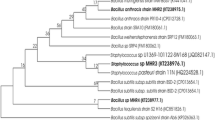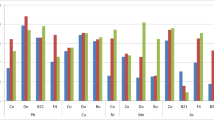Abstract
Abandoned magnesite mine heap causing pollution to nearby farmland and water reservoir. Thus the intention of this research was to screening metal mobilizing and absorbing bacteria from the rhizosphere section of V. unguiculata from farmland nearby to magnesite mine. Further, studied their stimulus effect on growth, biomass, and phytoextraction prospective of V unguiculata in mine tailing. The results of the physicochemical properties of mine tailing shows that four metals (Pb, Mn, Cd, and Zn) were crossing the permissible limit. Out of 27 isolates, 2 isolates (MMS15 and MMS17) were identified with maximum metal tolerance for up to 700 mg L−1 (MIC) and metal mobilization (Pb 5.5 and 5.87, Mn 6.6 and 4.88, Cd 1.99 and 2.59, and Zn 6.55 and 6.94 mg kg−1) and biosorption efficiency as Pb 3.74 and 3.74, Mn 4.9 and 4.7, Cd 2.41 and 3.96, and Zn 4.3 and 4.9 mg g−1. These two strains were identified as members of B. cereus and Kosakonia sp. using 16S rRNA technique and labelled strains NDRMN001 and MGR1, respectively. The Kosakonia sp. MGR1 effectively fixes the nitrogen in the rate of 81.94% and B. cereus NDRMN001 solubilizes 69.98 ± 2.31 mg L−1 of soluble phosphate. The experimental group’s study results show that the group C (Kosakonia sp. MGR1 and B. cereus NDRMN001) has effectively stimulate the growth, biomass, and phytoextraction potential of V. unguiculata. The results conclude that the optimistic interaction between these two bacteria could be more significant to minimize the metal pollution in magnesite mine tailing.




Similar content being viewed by others
Data availability
The detailed methodology and analytical data of the present findings are available from the corresponding author on reasonable request.
Code availability
Not applicable.
References
Aboushanab R, Angle J, Chaney R (2006) Bacterial inoculants affecting nickel uptake by Alyssum murale from low, moderate, and high Ni soils. Soil Biol Biochem 38:2882–2889. https://doi.org/10.1016/j.soilbio.2006.04.045
Branco R, Chung AP, Veríssimo A, Morais PV (2005) Impact of chromium-contaminated wastewaters on the microbial community of a river. FEMS Microbiol Ecol 54:35–46. https://doi.org/10.1016/j.femsec.2005.02.014
Braud A, Jézéquel K, Bazot S, Lebeau T (2009) Enhanced phytoextraction of an agricultural Cr- and Pb-contaminated soil by bioaugmentation with siderophore-producing bacteria. Chemos 74:280–286. https://doi.org/10.1016/j.chemosphere.2008.09.013
Chen L, Luo SL, Li XJ, Wan Y, Chen JL, Liu CB (2014) Interaction of Cd-hyperaccumulator Solanum nigrum L. and functional endophyte Pseudomonas sp. Lk9 on soil heavy metals uptake. Soil Biol Biochem 68:300–308. https://doi.org/10.1016/j.soilbio.2013.10.021
Chopin EIB, Alloway BJ (2007) Distribution and mobility of trace elements in soils and vegetation around the mining and smelting areas of Tharsis, Riotinto, and Huelva, berian Pyrite Belt, SW Spain. Water Air and Soil Poll 182(1–4):245–261
Das S, Kumar DT (2017) Microbial assay of N2 fixation rate, a simple alternate for acetylene reduction assay. Methods X. https://doi.org/10.1016/j.mex.2017.11.010
Fang Q, Fan Z, Xie Y, Wang X, Li K, Liu Y (2016) Screening and evaluation of the bioremediation potential of Cu/Zn-resistant, autochthonous Acinetobacter sp. FQ-44 from Sonchus oleraceus L. Front Plant Sci 7:1487. https://doi.org/10.3389/fpls.2016.01487
Deka G, Bhattacharyya KG (2009) Enrichment of Cr, Mn, Ni, and Zn in Surface Soil. Inter J Civ Environ Engi 1(3):145–147
Guo J, Tang S, Ju X, Ding Y, Liao S, Song N (2011) Effects of inoculation of a plant growth-promoting Rhizobacterium, Burkholderia sp. D54 on plant growth and metal uptake by a hyperaccumulator Sedum alfredii hance grown on multiple metal contaminated soil. World J Microbiol Biotechnol 27:2835–2844. https://doi.org/10.1007/s11274-011-0762-y
Hao X, Kwunlun L, Wang R, Sun W, Li Y (2010) The geomicrobiology of bauxite deposits. J Geoscie Fronti 1:81–89
Jiang CY, Sheng XF, Qian M, Wang QY (2008) Isolation and characterization of a heavy metal-resistant Burkholderia sp. from heavy metal contaminated paddy field soil and it’s potential in promoting plant growth and heavy metal accumulation in metal-polluted soil. Chemos 72:157–164. https://doi.org/10.1016/j.chemosphere.2008.02.006
Jing YX, Yan JL, He HD, Yang DJ, Xiao L, Zhong T (2014) Characterization of bacteria in the rhizosphere soils of Polygonum pubescens and their potential in promoting growth and Cd, Pb, Zn uptake by Brassica napus. Intern J Phytorem 16:321–333 https://doi.org/10.1080/15226514.2013.773283
Karakagh RM, Chorom M, Motamedi H, Kalkhajeh YK, Oustan S (2012) Biosorption of Cd and Ni by inactivated bacteria isolated from agricultural soil treated with sewage sludge. Ecohydrol Hydrobiol 12:191–198. https://doi.org/10.1016/S1642-3593(12)70203-3
Khan MU, Sessitsch A, Harris M, Fatima K, Imran A, Arslan M (2015) Cr-resistant rhizo- and endophytic bacteria associated with Prosopis juliflora and their potential as phytoremediation enhancing agents in metal degraded soils. Front Plant Sci 5:755. https://doi.org/10.3389/fpls.2014.00755
Lasat MM (2002) Phytoextraction of Toxic Metals-A review of biological mechanisms. J Environ Qua 31:109–120
Lucy M, Reed E, Glick BR (2004) Applications of free-living plant growth-promoting rhizobacteria. Anto Van Leeu 86:1–25. https://doi.org/10.1023/B:ANTO.0000024903.10757.6e
Ma Y, Prasad M, Rajkumar M, Freitas H (2011) Plant growth-promoting rhizobacteria and endophytes accelerate phytoremediation of metalliferous soils. Biotechnol Adv 29:248–258. https://doi.org/10.1016/j.biotechadv.2010.12.001
Mathiyazhagan N, Natarajan D (2011a) Bioremediation on effluents from Magnesite and Bauxite mines using Thiobacillus spp and Pseudomonas spp. J Bioremed Biodegrad 2:115. https://doi.org/10.4172/2155-6199.1000115
Mathiyazhagan N, Natarajan D (2011b) Assessment of physicochemical and heavy metals from waste dumps of magnesite and bauxite mines. Elec J of Environ Agri Food chem 10(11):3076–3082
Mathiyazhagan N, Natarajan D (2012) Impact of mine waste dumps on growth and biomass of economically important crops. J Environ Biol 33:1069–1074
Mathiyazhagan N, Natarajan D (2013) Phytoremediation efficiency of edible and economical crops on waste dumps of bauxite mines, Salem district, Tamil Nadu, India. In: Ramkumar M. (eds) On a Sustainable Future of the Earth's Natural Resources. Springer Earth System Sciences. Springer, Berlin, Heidelberg https://doi.org/10.1007/978-3-642-32917-3_31.
McGrath SP, Cunliffe CH (1985) A simplified method for the extraction of the metals Fe, Zn, Cu, Ni, Cd, Pb, Ni, Cr Co, and Mn from soil and sewage sludge. J Sci Food Agric 36:794–798
Hur M, Park S-J (2019) Identification of microbial profiles in heavy-metal-contaminated soil from full-length 16S rRNA Reads Sequenced by a Pac Bio System. Microorg 7:357. https://doi.org/10.3390/microorganisms7090357
Naga Raju M, Golla N, Vengatampalli R (2017) Soil physicochemical properties. in: soil enzymes. springer briefs in environmental science. Springer, Cham. https://doi.org/10.1007/978-3-319-42655-6_2
Narayanan M, Kumarasamy S, Ranganathan M, Kandasamy S, Kandasamy G, Gnanavel K (2020a) Enzyme and metabolites attained in degradation of chemical pesticides ß Cypermethrin by Bacillus cereus. Procee Mater Today. https://doi.org/10.1016/j.matpr.2020.05.722
Narayanan M, Kumarasamy S, Ranganathan M, Kandasamy S, Kandasamy G, Gnanavel K (2020b) Production and characterization of polyhydroxyalkanoates synthesized by E. coli Isolated from sludge soil, Mater Today: Procee https://doi.org/10.1016/j.matpr.2020.05.725.
Nies DH (2003) Efflux-mediated heavy metal resistance in prokaryotes. FEMS Microbiol Rev 27:313–339. https://doi.org/10.1016/S0168-6445(03)00048-2
Oliveira A, Pampulha ME, Neto MM, Almeida AC (2010) Mercury tolerant diazotrophic bacteria in a long-term contaminated soil. Geoder 154:359–363
Osakwe S.A, Otuya O.B (2008) Elemental composition of soils in some mechanic dumpsites in agbor, delta state, Nigeria. Proceedings of Chemical Society of Nigeria 557–559
Rajkumar M, Freitas H (2008) Influence of metal resistant-plant growth-promoting bacteria on the growth of Ricinus communis in soil contaminated with heavy metals. Chemos 71:834–842. https://doi.org/10.1016/j.chemosphere.2007.11.038
Rajkumar M, Sandhya S, Prasad M, Freitas H (2012) Perspectives of plant-associated microbes in heavy metal phytoremediation. Biotechnol Adv 30:1562–1574. https://doi.org/10.1016/j.biotechadv.2012.04.011
Ramamurthy N, Kannan S (2009) SEM-EDS analysis of soil and plant (Calotropis giganteaL) collected from industrial Village, Cuddalore Dt, Tamilnadu, India. Romanian. J Biophy 19(3):219–226
Rojas-Tapias DF, Bonilla RR, Dussán J (2012) Effect of inoculation with plant growth-promoting bacteria on growth and copper uptake by sunflowers. Water Air Soil Pollut 223:643–654. https://doi.org/10.1016/j.jhazmat.2011.02.075
Rufus J, Akinrinlola Gary Y, Yuen Rhae A, Drijber AO, Adesemoye, (2018) Evaluation of Bacillus strains for plant growth promotion and predictability of efficacy by in vitro physiological traits. Intern J Microbio. https://doi.org/10.1155/2018/5686874
Jiang W, Tao T, Liao Z (2011) Removal of heavy metal from contaminated soil with chelating agents. Open J Soil Sci 1:70–76. https://doi.org/10.4236/ojss.2011.12010
Wenzel W, Bunkowski M, Puschenreiter M, Horak O (2003) Rhizosphere characteristics of indigenously growing nickel hyperaccumulator and excluder plants on serpentine soil. Environ Pollut 123:131–138. https://doi.org/10.1016/S0269-7491(02)00341-X
Yoon J, Cao X, Zhou Q, Ma LQ (2006) Accumulation of Pb, Cu, and Zn in native plants growing on a contaminated Florida site. Sci Total Environ 368:456–464. https://doi.org/10.1016/j.scitotenv.2006.01.016
Zahir ZA, Ghani U, Naveed M, Nadeem SM, Asghar HN (2009) Comparative effectiveness of Pseudomonas and Serratia sp. containing ACCdeaminase for improving growth and yield of wheat (Triticum aestivum L.) under salt-stressed conditions. Arch Microbiol 191:415–424. https://doi.org/10.1007/s00203-009-0466-y
Zaidi S, Usmani S, Singh BR, Musarrat J (2006) Significance of Bacillus subtilis strain SJ-101 as a bioinoculant for concurrent plant growth promotion and nickel accumulation in Brassica juncea. Chemos 64:991–997. https://doi.org/10.1016/j.chemosphere.2005.12.057
Acknowledgement
The authors are thankful to the PG and Research Centre in Biotechnology, MGR College, Hosur, Tamil Nadu, India for offering a sophisticated lab facility for successful completion of this study. The first author thank Miss Asra Parveen (Magizhmathi), ASO, Department of Finance, Secretariat, Govt. of Tamil Nadu, India for cordial assistance.
Funding
Not applicable.
Author information
Authors and Affiliations
Contributions
MN planned the outline of the research work, carried out the research, and prepared the manuscript, while all G.K. support the manuscript writing. M.R and S.K, support result analysis. The authors have read and approved the final manuscript.
Corresponding author
Ethics declarations
Conflict of interests
The authors declare that they have no competing interests.
Ethical approval
Copy enclosed.
Additional information
Communicated by Erko Stackebrandt.
Publisher's Note
Springer Nature remains neutral with regard to jurisdictional claims in published maps and institutional affiliations.
Electronic supplementary material
Below is the link to the electronic supplementary material.
Rights and permissions
About this article
Cite this article
Narayanan, M., Ranganathan, M., Kandasamy, G. et al. Evaluation of interaction among indigenous rhizobacteria and Vigna unguiculata on remediation of metal-containing abandoned magnesite mine tailing. Arch Microbiol 203, 1399–1410 (2021). https://doi.org/10.1007/s00203-020-02115-3
Received:
Revised:
Accepted:
Published:
Issue Date:
DOI: https://doi.org/10.1007/s00203-020-02115-3




